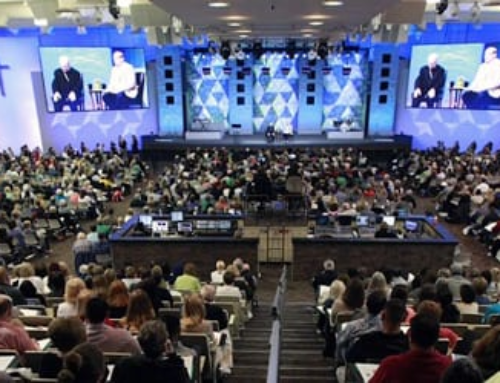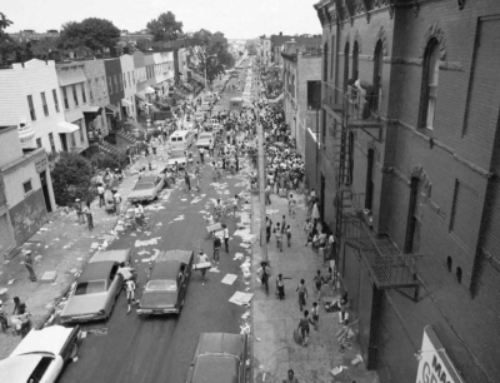From Preaching to Politics
How hard could that be?
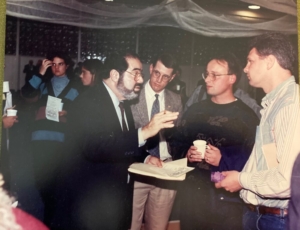 I graduated from the Assemblies of God Theological Seminary with an M.A. in Biblical languages, and had an eventual goal of teaching at an Assemblies of God Bible College. Since the Assemblies of God valued ministerial experience, it behooved me to seek a position at a local church. So, with no prior ministry experience, I accepted an opportunity to plant a brand new church in a bedroom community of New York City.
I graduated from the Assemblies of God Theological Seminary with an M.A. in Biblical languages, and had an eventual goal of teaching at an Assemblies of God Bible College. Since the Assemblies of God valued ministerial experience, it behooved me to seek a position at a local church. So, with no prior ministry experience, I accepted an opportunity to plant a brand new church in a bedroom community of New York City.
The New York District of the Assemblies of God had contacted me to let me know there was a potential congregation composed of four families looking for a pastor. Unfortunately, the district did not know the backstory.
These families had been instrumental in a church split in New Milford, Connecticut. They, along with the youth pastor, left to start their own church without the existing church’s blessing. Within two years, that church venture failed.
Shortly thereafter, several of these families contacted the Connecticut District of the Assemblies God and asked for their assistance to start another church. The district gave them a hard “No.” Being only a few miles from the state line, they called the New York District and asked them for help. Not knowing their history, the New York District said, “Sure and we have just the young pastor for you.”
At the age of 24, I had no idea what types of questions to ask. Kris and I happily visited with these families. I preached a sermon and led a Bible study. They voted on us and offered us the position. The New York District guaranteed our initial financial backing. We accepted the offer. That summer we pulled a small U-Haul trailer with alacrity to our new home in Duchess County. Eventually, we learned some of the questions we should have asked.
Within a year, the church grew from those four original families to nearly 60 people every Sunday. But then, their warts and my flaws began to show. I made the inevitable ministry mistakes that a cocky 20-something would make. The people in our congregation weren’t the type who worked through their problems. Things began to rapidly deteriorate. Shortly after our first child was born, the rental building in which we were worshipping burned down to the ground, sealing our fate. Our dreams went up in smoke.
After three years of ministry, I was deeply wounded and defeated. At the age of 27, I retired from ministry. We moved to my wife’s hometown of Bettendorf, Iowa. Determined never to be involved in full-time ministry again, I began a new career in banking and finance.
Being a book worm, I began to read numerous economic books. I read authors from the Austrian School of Economics, including Von Mises, Murray Rothbard and Frederick Hayek. The Austrian School of Economics had a profound influence on Milton Friedman, Ayn Rand, and Federal Reserve Chairman, Alan Greenspan. Austrian economic theories were the founding principles of the CATO Institute and the Heritage Foundation.
This Economic theory is more commonly referred to as “Supply-Side Economics” or “Trickle-Down Economics.” In essence, they believe that the market is always right and should never be regulated. Markets must be free. These economists argue that any type of government interference or assistance impinges on human freedom.
Recently, my mother-in-law gently reminded me that when Kris and I transitioned from ministry, we relied on a government program called “WIC” for several years. I acknowledged that without rebuttal. She also pointed out that we had purchased our home courtesy of an FHA loan. Yes, that was true, too, but somehow that was different. I was never able to articulate how it was different, but I was sure that it was different.
Cognitive dissonance can be a fickle thing. I wonder if some members of the CATO Institute have ever accepted FEMA assistance or used an FHA loan to purchase a home. I also wondered if their business benefactors had accepted TARP funds or PPP loans, but I digress.
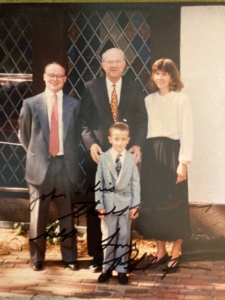 Being a county chairman offered me some once in a lifetime experiences. One evening, Kris and I chauffeured Iowa Governor Branstad and Congressman Lightfoot to a campaign rally. After I dropped them off, I drove out to the municipal airport to take former Vice-President Dan Quayle to the same event. Our baby daughter, Joy, made the local news that evening with Governor Branstad holding her in his arms. Marilyn Quayle also held her, but unfortunately, the news didn’t capture that moment.
Being a county chairman offered me some once in a lifetime experiences. One evening, Kris and I chauffeured Iowa Governor Branstad and Congressman Lightfoot to a campaign rally. After I dropped them off, I drove out to the municipal airport to take former Vice-President Dan Quayle to the same event. Our baby daughter, Joy, made the local news that evening with Governor Branstad holding her in his arms. Marilyn Quayle also held her, but unfortunately, the news didn’t capture that moment.
Congressman Lightfoot fell a few points shy of unseating Senator Harkin. Despite having experienced two campaign defeats in one campaign season, I pressed on with my political involvement.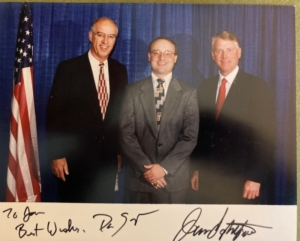
My new venture entailed social activism. Planned Parenthood was attempting to establish a health center near the Bettendorf High School. This center would not provide abortions. It would provide birth control and health services for those with STD’s. We were convinced, however, that allowing Planned Parenthood in our community would be the first step to having an abortion clinic in our town. Churches mobilized against the health center. Kris and I attended protests, prayer vigils, and city council hearings. We didn’t have a leadership role in the opposition, but supported the effort all that we could. After the city council voted the project down, Planned Parenthood sued the city. Planned Parenthood quickly won their case in the courts.
Before breaking ground on its new center, Planned Parenthood participated in Bettendorf’s 4th of July parade. This caught me totally off guard. As my anger began to boil over, I shouted at their float, “Nobody wants you here!” and “Why are you ruining our parade?,” “You’re a bunch of baby killers!”
I yelled at them non-stop until their float was no longer in view.
After I caught my breath, I looked around for Kris and the kids, but they were nowhere to be found. She had deftly taken our children to quieter quarters. Not only was my family gone, but there was a visible gap all around me. My family weren’t the only ones who left my side. I had just made a spectacle of myself.
I reflected on what had just happened. I realized that I didn’t just disagree with these strangers. I viscerally hated them. It turns out that Planned Parenthood wasn’t my problem. My inability to “love my enemies” was the problem (Matthew 5:43-45).
How did I get so invested in trusting political solutions for spiritual problems? As I reflected on my own transformation, I reflected on the transformation of American politics as well.
America’s political transformation was a gradual one. From the end of Reconstruction in in 1877 until 1948, the South had been a democratic stronghold. The New Deal Coalition included white southerners, as well as unions, and immigrants. Somehow, between 1877 to 1997, the south transformed from deep-blue to dee-red. Race was a big reason for this shift.
1948 marked the first time the entire Deep South (Louisiana, Mississippi, Alabama, Georgia, and South Carolina) did not vote for a democratic presidential nominee. The South left Truman over black Civil Rights. In 1948, Harry S. Truman issued Executive Order 9981, desegregating the military. When President Truman insisted that Civil Rights be a plank of the Democratic Party’s Platform, a group of “States Rights” southern Democrats, known as Dixiecrats, bolted from the party.
The only state’s right that concerned Dixiecrats was the right to Jim Crow segregation. They selected a vocal segregationist, South Carolina’s Gov. Strom Thurmond, as their party’s standard bearer. In many southern states, President Truman did not even appear on the ballot. The 1948 election marked the first time since Reconstruction that the Deep South, with the exception of Georgia, did not vote for the Democratic Presidential nominee. They voted for Strom Thurmond and segregation instead.
The second time that the Post Reconstruction south broke ranks with the Democratic party was in 1964 (Louisiana was the lone Deep South state that voted for Eisenhower in 1956). In 1964, President Johnson had signed the Civil Rights Act which ended race-based discrimination. Arizona Sen. Barry Goldwater was one of only six Republican Senators who voted against the Civil Rights Act. The Bill had passed the Senate 73 – 27. All but one southern Democratic Senator voted against it.
Articulating free market orthodoxy, Sen. Goldwater argued it was unconstitutional to give the Federal Government any power over private businesses to dictate whom they could hire. He believed there was never justification for market interference. The market is always right. If the market set a price on labor, housing, or services based on racial discrimination, that was the market’s prerogative. Only the market knows what things are worth. In his 1964 bid for President, Barry Goldwater only carried six states: his home state of Arizona and all five Deep South states.
The third time the Deep South broke with the Democratic Presidential nominee was four years later. Again, the issue was race. In 1965, President Johnson pushed for the Voting Rights Act, that outlawed the discriminatory voting practices, including literacy tests. In 1968, President Johnson shepherded the passage of the Fair Housing Act, which prohibited race-based discrimination concerning the sale, the rental, and financing of housing.
White southern resentment fomented against the myriad of major Civil Rights legislations passed under Johnson. During the 1968 Presidential election cycle, Democratic governor of Alabama, George Wallace, declared his candidacy for President as a third-party candidate. He harnessed the anger of southern whites who felt abandoned by their federal government. George Wallace equated black Civil Rights protests to anarchy and lawlessness. His call for “Law and Order,” was his clarion call to end Civil Rights agitation and advancement. There would be no more Civil Rights protests under his watch. His message resonated in the south. He garnered all the Deep South States, except for South Carolina. Wallace also carried Arkansas and a congregational district in North Carolina.
This voting pattern demonstrates the south’s stiff resistance against black Civil Rights and the government’s policies to end discrimination and segregation. One case in point was the 1954 Supreme Court ruling in Brown vs. the Board of Education. Southern states were not shy in exhibiting their singular determination not to integrate its colleges or its public schools. The University of Louisiana at Lafayette was the lonely exception to this trend. UL Lafayette had a quiet mass integration that very autumn. Integration in the rest of the southern universities would have to wait until the 1960’s.
 Integrating public schools was no easier than the universities. In 1957, President Dwight D. Eisenhower was left with no alternative but to send the 101st Airborne “Screaming Eagles” to Little Rock, Arkansas to escort nine black students to Central High School. The following year Little Rock came up with a new way to thwart federal desegregation. The city shut down all their public schools for two full years.
Integrating public schools was no easier than the universities. In 1957, President Dwight D. Eisenhower was left with no alternative but to send the 101st Airborne “Screaming Eagles” to Little Rock, Arkansas to escort nine black students to Central High School. The following year Little Rock came up with a new way to thwart federal desegregation. The city shut down all their public schools for two full years.
Despite the Federal Government’s efforts, our public schools remain extremely segregated. Several studies have demonstrated that segregation in our public schools today is actually worse than it was in the late 1960’s. Today, more than 75% of black students attended schools that are less than 25% white. White flight and the rapid growth of private schools are part of the explanation for this.
In an ongoing effort to evade integration, private Christian schools, known as segregation academies began to pop up all across the south. Non-Catholic Christian schools doubled their enrollments between 1961 and 1971. From 1970 to 1980, private Christian school enrollment doubled again, from 560,000 to 1.3 million students. Today, 9% of all students are enrolled in private schools. Louisiana has the second highest state rate of private school enrollment in the country, at 19%. Lafayette, Louisiana has 26% of its students enrolled in private schools.
As a result of the mass migration of white families to private schools, our public schools are much browner and poorer than they were before forced busing. In the 1970’s, 79% of all public-school students were white. Today, that number is below 50%. As recently as in 1989, only 32% of U.S. public school students came from low-income families. Today, more than 50% of our public-school students attending are considered low income. In Lafayette, more than 60% of the public schools’ students come from low-income families. The continuance of public-school segregation and the growth of private school enrollment is one of the many lasting legacies of our Jim Crow past.
In the 1970’s, the Nixon administration notified the segregation academies that they could no longer have official policies that excluded black student enrollment. De-facto segregation, however, continued. The federal government then took active steps to end De-facto segregation. In 1978, the Carter Administration informed Jerry Falwell and his Liberty Christian Academy (which had opened as a Segregation Academy in 1967) that if they did not enroll black students, their tax-exempt status would be revoked. Jerry Falwell formed the Moral Majority the following year. The formation of the Moral Majority marked a decided shift in the nature and level of evangelical Christian involvement in political activism.
Following the results of the 1964 and 1968 Presidential elections, Republican strategists developed a “Southern Strategy.” The Southern Strategy was a tactic designed to appeal to southern voters without explicitly mentioning race. In 1981, Ronald Reagan’s political advisor, Lee Atwater, described it this way:
“You start out in 1954 by saying, “N*****, n*****, n*****”. By 1968, you can’t say “n*****”—that hurts you. Backfires. So, you say stuff like forced busing, states’ rights and all that stuff. You’re getting so abstract now [that] you’re talking about cutting taxes, and all these things you’re talking about are totally economic things and a byproduct of them is [that] blacks get hurt worse than whites…. I’m saying that if it is getting that abstract, and that coded, that we are doing away with the racial problem one way or the other. You follow me—because obviously sitting around saying, “We want to cut this”, is much more abstract than even the busing thing, and a hell of a lot more abstract than “N*****, n*****”. So, any way you look at it, race is coming on the back-burner.”
With this strategy in mind, Ronald Reagan’s first campaign stop as the Republican nominee for President was the Neshoba County Fair, in Philadelphia, Miss. In his stump-speech, Reagan proclaimed, “I believe in states’ rights; I believe in people doing as much as they can for themselves at the community level and at the private level.” He pledged that if he were President, the Federal Government would no longer dominate your lives – a not so veiled allusion to forced federal desegregation.
The location of this first rally was thoughtfully selected to make a lasting impression on southern white voters. The fairgrounds were less than three miles away from here three civil rights workers helping blacks register to vote were murdered by KKK members and then buried in shallow 16 years earlier. Philadelphia, Mississippi, had been a frequent rallying point of black Civil Rights activists, drawing attention to the town’s cruel history. It did not go unnoticed by his southern audience that Ronald Reagan carefully made no mention of the terrible crime that had occurred there. His coded message was well received.
On July 14, 2005, Ken Mehlman, the Republican National Committee chairman, apologized to the NAACP at its national convention in Milwaukee for the Republican use of the Southern Strategy. He admitted that Republicans looked “to benefit politically from racial polarization.” He admitted that subtly appealing to the racism of voters through coded speech was “wrong.”
Regardless its morality, the strategy had worked. Over time, the former FDR, New-Deal Democrats had become fervent fiscal conservatives. I too became an ardent advocate of free market economics, without fully understanding the forces that made it desirable to many.
Now, it could be true that having absolutely free markets might be the best economic policy, but having free markets is not a system of justice. Free markets don’t work equally well for everyone. Free markets are not designed to address economic harms.
It was an unregulated free market that allowed racial discrimination. In the 1960s, a person could remain unemployed solely on the basis of his skin color. A free market allowed for an employer to pay black folks less for the same work. The free market allowed restaurants not to serve people of color. Free markets allowed for colleges to choose to discriminate against prospective black students. Free markets allowed landlords to charge black families more money or not to rent to them at all. You see, in a racist society, the market is only free if you are white. The market knows what society’s demands are. When society is racist, the market harms some and benefits others. The market may always be right in determining society’s value of something, but the market’s value may not be just.
In 1960, America was 80% white. If blacks were poor because the majority white society was racist, placing no value on black labor and unwilling to do business with them, having a free market could not fix that. Those who have the wealth and provide jobs and have all the leverage. Those were the insights of the Southern Strategy. In the 1980’s, when folks were advocating for States Rights, no more government intervention, and no more Affirmative Action, the real message was that we liked our segregated, unequal, and unjust society. You can’t force me to want a black neighbor or to allow black children in our schools.
The free market doesn’t work well for everyone. It does not work for the oppressed, since society does not value them. The free market also doesn’t work well for the unskilled 51-year-old Singer Sewing Machine employee who lost his manufacturing job to children in a sweatshop in China. In an unregulated market, a multinational conglomerate’s only loyalty is to its international shareholders. It has absolutely no concern for its corporate stakeholders, no loyalty to U.S. citizens, and no sense of responsibility to its employees. This system works for the conglomerates, but harms working class families.
The market may always right, but is it just? Is it fair to hard working American citizens? The free market doesn’t work well for the disabled, the generationally poor, older Americans who lack marketable skills, or those being discriminated against. Their contribution to the economy is of little value.
As my mother-in-law pointed out to me, the free market very seldom provides for home ownership in America. It wasn’t until the federal government intervened and created FHA backed loans that home ownership became common place. In 1997, I would have argued, “That has to be different somehow. I am not exactly sure how, but it’s different.”
We do need strong markets. Markets inspire innovation, provide efficiency, and produce wealth. Markets, however, do not provide transformative justice. And yes, there are plenty of examples of government overreach. Let’s not get trapped in “either-or” thinking.
In attempting to redress racial harms, aspects of Affirmative Action and forced busing caused new harms. This is a truth. Yet, can we admit that our country has had racial problems in our past? Can we go further than that and acknowledge that our racial history has left a legacy that continues to cause harm today? Can we ponder how living in high poverty, high crime, low employment neighborhoods is a toxic environment for vulnerable children? Can we acknowledge that most of these high poverty neighborhoods continue to be a lasting legacy to our history of redlining, racial covenants, and white flight? Can we fathom the possibility that the racism of the 1950’s might be dead, but that the structural and systemic racism remains?
These are questions that I didn’t know to ask in 1997. I never reflected on our past racial harms. They weren’t part of my experience. I viewed those who asked such questions as my political enemies. It never occurred to me to try to understand why my political opponents thought the way that they did. Maybe I could have discovered some common ground. I may not have agreed with their solutions, but maybe I would have better understood the problem.
More important for me was that my political opponents were the objects of my anger. My visceral hatred of them was apparent for all to see that July 4th in Bettendorf. Yet, those I hated were those whom God loved. At that moment, it began to dawn on me that my political attitudes were poisoning my very soul. What I was reading and what I was listening to produced bitterness and anger. It hindered my ability to love and blinded me to the truth. Instead, I needed to focus on the one who came to “Preach the Good News to the poor.” I needed more understanding, more empathy, and more curiosity.
I needed to learn to love the way Jesus loved, and I needed to see the world the way He sees it. On July 4th, 1997, I stood alone as a man in need of God’s transforming love.




